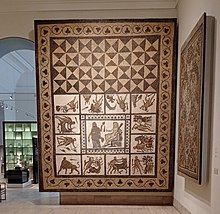
Back أعمال هرقل Arabic Daouzek trevell Herakles Breton Els dotze treballs d'Hèracles Catalan Herakles' tolv arbejder Danish Άθλοι του Ηρακλή Greek La dek du laboroj de Heraklo Esperanto Los doce trabajos de Heracles Spanish Heraklese vägitööd Estonian Heraklesen hamabi lanak Basque دوازدهخان هرکول Persian


The Labours of Hercules or Labours of Heracles (Ancient Greek: ἆθλοι, âthloi[1] Latin: Labores) are a series of tasks carried out by Heracles, the greatest of the Greek heroes, whose name was later romanised as Hercules. They were accomplished in the service of King Eurystheus. The episodes were later connected by a continuous narrative.
The establishment of a fixed cycle of twelve labours was attributed by the Greeks to an epic poem, now lost, written by Peisander (7th to 6th centuries BC).[2]
Having tried to kill Heracles ever since he was born, Hera induced a madness in him that made him kill his wife and children. Afterwards, Heracles went to the Oracle of Delphi to atone, where he prayed to the god Apollo for guidance. Heracles was told to serve Eurystheus, king of Mycenae, for ten years. During this time, he was sent to perform a series of difficult feats, called labours.[3]
- ^ LSJ, ἆθλος.
- ^ Brill's New Pauly, s.v. Peisander (6).
- ^ Hard, p. 253.